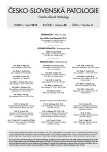Neurodegenerative Disorders: Review of Current Classification and Diagnostic Neuropathological Criteria
Authors:
R. Matěj 1; R. Rusina 2
Authors‘ workplace:
Centrum pro diagnostiku a studium neurodegenerativních onemocnění
; Oddělení patologie a molekulární medicíny FTNsP, Praha
1; Neurologická klinika IPVZ a FTNsP, Praha
2
Published in:
Čes.-slov. Patol., 48, 2012, No. 2, p. 83-90
Category:
Review Articles – Neuropathology
Overview
Neurodegenerative disorders are progressive diseases characterized by loss of specific neuronal populations followed by a clinical picture of a different neurodegenerative entity. Current classification of these diseases respects the names of the main pathophysiological processes involved in the groups of disorders. This is the reason why key proteins which represent neuropathological and biochemical hallmarks of diseases are found in their names. Neuropathological diagnosis is a synthesis of neurohistological changes in the brain and spinal cord and identification of pathological proteinaceous aggregates in neurons and/or glial cells. These inclusions are predominant diagnostic micromorphological and biochemical markers of disease. In the text, there is a brief summary of current knowledge about pathophysiology of neurodegenerations and diagnostic criteria for the most frequent entities.
Keywords:
neurodegeneration – Alzheimer disease – classification – neuropathology
Sources
1. Dickson DW ed. Neurodegeneration: The Molecular Pathology of Dementia and Movement Disorders. Basel: ISN Neuropath Press, 2003.
2. Love S, Louis DN, Ellison DW. (eds). Greenfieldęs Neuropatology 8th edition. Hodder Arnold, 2008: 889–1264.
3. Quertfurth HW, LaFerla FM. Alzheimeręs disease. New Engl J Med 2010; 362: 329–344.
4. Braak H, Braak E. Neuropathological stageing of Alzheimer-related changes. Acta Neuropathologica 1991; 82: 239–259.
5. Jack CR Jr, Albert MS, Knopman DS, et al. Introduction to the recommendations from the National Institute on Aging-Alzheimer’s Association workgroups on diagnostic guidelines for Alzheimer’s disease. Alzheimers Dement 2011; 7(3): 257–62.
6. OMIM On-line Mendelian Inheritance in Man. http://www.ncbi.nlm.nih.gov/omim
7. McKhann GM, Knopman DS, Chertkow H, et al. The diagnosis of dementia due to Alzheimer’s disease: recommendations from the National Institute on Aging-Alzheimer’s Association workgroups on diagnostic guidelines for Alzheimer’s disease. Alzheimers Dement 2011; 7: 263–269.
8. Alafuzoff I, Arzberger T, Al-Sarraj S, et al. Staging of neurofibrillary patology in Alzheimeręs disease: a study of the BrainNet Europe Consortium. Brain Pathol 2008; 18: 484–496.
9. Dickson DW, Kouri N, Murray ME, et al. Neuropathology of Frontotemporal Lobar Degeneration-Tau (FTLD-Tau). J Mol Neurosci 2011: Jul 1. [Epub ahead of print]
10. Bigio EH. Update on recent molecular and genetic advances in frontotemporal lobar degeneration. J Neuropathol Exp Neurol 2008; 67: 635–648.
11. Sleegers K, Cruts M, Van Broeckhoven C. Molecular pathways of frontotemporal lobar degeneration. Annu Rev Neurosci 2010; 33: 71–88.
12. Kertesz A, McMonagle P, Blair M, et al. The evolution and pathology of frontotemporal dementia. Brain 2005; 128: 1996–2005.
13. Hodges JR, Patterson K. Semantic dementia: a unique clinicopathological syndrome. Lancet Neurol 2007; 6:1004–1014.
14. Williams DR, Lees AJ. Progressive supranuclear palsy: clinicopathological concepts and diagnostic challenges. Lancet Neurol 2009; 8: 270–279.
15. Fujino Y, Wang DS, Thomas N, et al. Increased frequency of argyrophilic grain disease in Alzheimer disease with 4R tau-specific immunohistochemistry. J Neuropathol Exp Neurol 2005; 65: 209–214.
16. Josephs KA, Whitwell JL, Parisi JE, et al. Argyrophilic grains: a distinct disease or an additive pathology? Neurobiol Aging 2008; 29: 566–573.
17. Neumann M, Sampathu DM, Kwong LK, et al. Ubiquitinated TDP-43 in frontotemporal lobar degeneration and amyotrophic lateral sclerosis. Science 2006; 314: 130–133.
18. Arai T, Hasegawa M, Akiyama H, et al. TDP-43 is a component of ubiquitin-positive tau-negative inclusions in frontotemporal lobar degeneration and amyotrophic lateral sclerosis. Biochem Biophys Res Commun 2006; 351: 602–611.
19. Chen-Plotkin AS, Lee VM, Trojanowski JQ. TAR DNA-binding protein 43 in neurodegenerative disease. Nat Rev Neurol 2010; 6: 211–220.
20. Cairns NJ, Bigio EH, McKenzie IRA. Neuropathologic and nosologic kriteria for frontotemporal lobar degeneration: consensus of the Consortium for Frontotemporal Lobar Denegeration. Acta Neuropathol 2007; 114: 5–22.
21. Mackenzie IR, Neumann M, Cairns NJ, et al. Nomenclature for neuropathologic subtypes of frontotemporal lobar degeneration: consensus recommendation. Acta Neuropathol 2009; 117: 15–18.
22. Ferrer I, Martinez A, Blanco R, et al. Neuropathology of sporadic Parkinson disease before the appearance of parkinsonism: preclinical Parkinson disease. J Neural Transm 2011; 118: 821–839.
23. Beach TG, Adler Ch H, Lue L, et al. Unified staging system for Lewy body disorders: correlation with nigrostriatal degeneration, cognitive impairment and motor dysfunction. Acta Neuropathol 2009; 117: 613–634.
24. McKeith IG, Dickson DW, Lowe DM, et al. Diagnosis and management of dementia with Lewy bodies: third report of the DLB consortium. Neurology 2005; 65: 1–11.
25. Wenning GK, Stefanova N, Jellinger KA, et al. Multiple system atrophy: a primary oligodendrogliopathy. Ann Neurol 2008; 64: 239-246.
26. Vonsattel J-PG. Huntington disease models and human neuropatology: similarities and differences. Acta Neuropathol 2008; 115: 55–69.
27. Geser F, Martinez-Lage M, Kwong LK, et al. Amyotrophic lateral sclerosis, frontotemporal dementia and beyond: the TDP-43 diseases. J Neurol 2009; 256: 1205–1214.
28. WHO manual for surveillance of human transmissible spongiform encephalopaties including variant Creutzfeldt-Jakob disease 2003. [http://whqlibdoc.who.int/publications/2003/9241545887.pdf]
29. Aguzzi A, Calella AM. Prions: protein aggregation and infectious diseases. Physiol Rev 2009; 89: 1105–1152.
30. Hill AF, Joiner S, Wadsworth JD, et al. Molecular classification of sporadic Creutzfeldt-Jakob disease. Brain 2003; 126: 1333–1346.
Labels
Anatomical pathology Forensic medical examiner ToxicologyArticle was published in
Czecho-Slovak Pathology

2012 Issue 2
Most read in this issue
- Neurodegenerative Disorders: Review of Current Classification and Diagnostic Neuropathological Criteria
- Neuropathology of refractory epilepsy: the structural basis and mechanisms of epileptogenesis
- Selected biomarkers in the primary tumors of the central nervous system: short review
- Micropapillary urothelial carcinoma of the ureter
